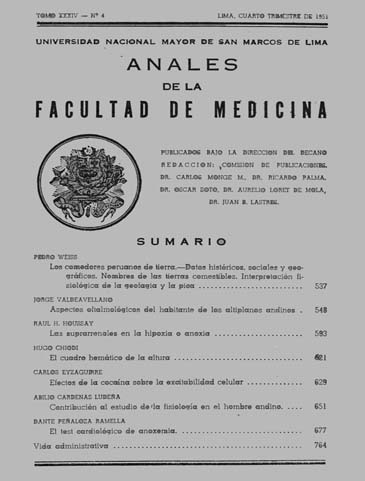The adrenal in hypoxia or anoxia
DOI:
https://doi.org/10.15381/anales.v34i4.9544Abstract
Decreased oxygen tension (hypoxia) is an emergency situation that subjects the body to stress (stress), which causes multiple changes, some specific or is due to decreased oxygen and other general information, such as the syndrome adaptation. If the animal survives an evolution of the phenomena observed in three phases: a) acute or alarm reaction; b) adaptation or acclimatization; c) mismatch or deacclimation or decompensation. The nervous system, initially stimulated by hypoxia modifies the function of the adrenal cortex and medulla. The action of the crust is because the central nervous action causes increased secretion of adrenocorticotropic hormone by the pituitary pars distalis. The action on the adrenal medulla consists of a stimulus on the upper sympathetic centers (hypothalamus, etc.), speaking the lower spinal cord and greater splanchnic nerves and produces a strong adrenaline rush. If hypoxia is severe or causes asphyxiation, the adrenaline rush is one of the strongest that can be observed and lasts several minutes. The initial reaction of the cortex through occurs when the pituitary and therefore lack in hipofisoprivos animals. Adrenocorticotropin discharge occurs: a) reduction of ascorbic acid, cholesterol and lipids in the skin; b) increased secretion of adrenocortical hormones produced decreased thymus and lymphatic tissue (lympholytic action); c) levels, lymphopenia and eosinofilopenia; d) increase in carbohydrates in the body, especially the liver glycogen in fasted animals exposed to hypoxia; e) increase in nitrogen excretion during the fasting; f) increased excretion of urinary 17-ketosteroids. During the adaptation or acclimatization increase again fat and cholesterol and raises the weight of the adrenal. During this adaptation or acclimatization, hypoxia is better supported and has a smaller decrease in adrenal ascorbic acid. Body weight had decreased regained. Several authors have shown that the active hormones on the metabolism of carbohydrates produce increased resistance to hypoxia. Did not occur with the extract we use and the conditions we experience. Adrenal appears to play a role in resistance to hypoxia. If it is permanent or repeated daily, it has been found that the support suprarrenoprivas rats. No check this in acute anoxia 2 hours either by short time of our experiments or rat race employed. It is easy to understand that the symptoms of shock produced by hypoxia with resulting adrenal insufficiency add to it. May lead to increased resistance of normal or even suprarrenoprivas rats gradually subjecting them once a day for short periods (2 hours) to depression undergoing. The permanent and prolonged severe hypoxia or repeated daily for long periods, it has been found eventually a loss of adaptation. It has been observed that reappear: lipid depletion in the cortex, the reduction of resistance to hypoxia, hypoglycemia, a tendency to subnormal temperature. etc. In short hypoxia causes increased activity of pituitary-adrenocortical system and, if severe, causes release of adrenaline from the adrenal medulla through sympathetic-méduloadrenal mechanism. The presence of adrenal function promotes the body's resistance during hypoxia, as in all cases of emergency. The increase in cortical and medullary functions can cooperate with other mechanisms of resistance of the organism, in a proportion that is difficult to determine quantitatively.Downloads
Published
1951-12-31
Issue
Section
Trabajos originales
License
Copyright (c) 1951 Raúl H. Houssay

This work is licensed under a Creative Commons Attribution-NonCommercial-ShareAlike 4.0 International License.
Those authors who have publications with this magazine accept the following terms:
- Authors will retain their copyrights and guarantee the journal the right of first publication of their work, which will be simultaneously subject to Creative Commons Attribution License that allows third parties to share the work as long as its author and its first publication this magazine are indicated.
- Authors may adopt other non-exclusive licensing agreements for the distribution of the version of the published work (eg, deposit it in an institutional electronic file or publish it in a monographic volume) provided that the initial publication in this magazine is indicated.
- Authors are allowed and recommended to disseminate their work over the Internet (eg: in institutional telematic archives or on their website) before and during the submission process, which It can produce interesting exchanges and increase quotes from the published work. (See El efecto del acceso abierto ).
How to Cite
1.
Houssay RH. The adrenal in hypoxia or anoxia. An Fac med [Internet]. 1951 Dec. 31 [cited 2024 Aug. 16];34(4):593-620. Available from: https://revistasinvestigacion.unmsm.edu.pe/index.php/anales/article/view/9544















